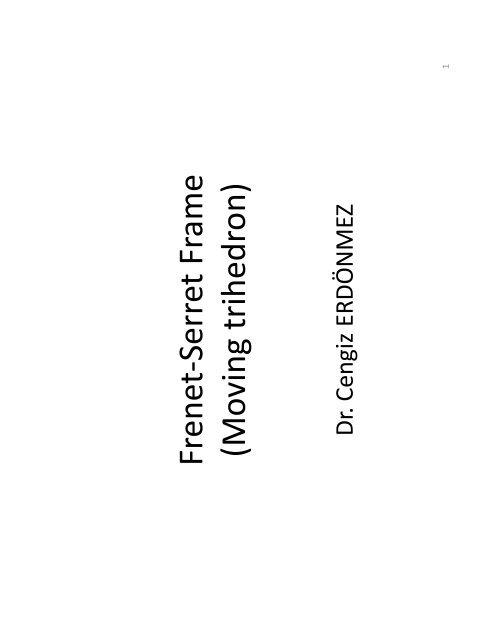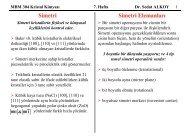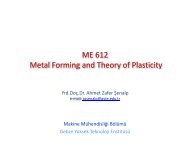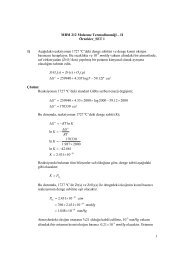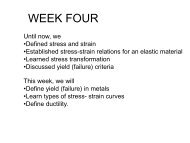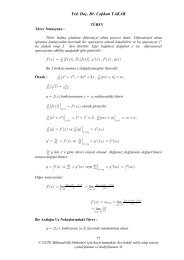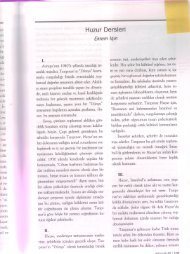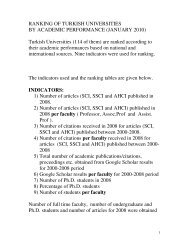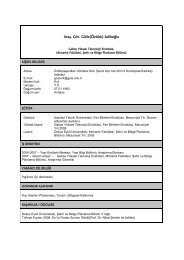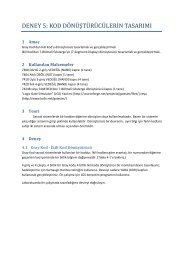Frenet-Serret Fram e (M oving trihedron)
Frenet-Serret Fram e (M oving trihedron)
Frenet-Serret Fram e (M oving trihedron)
You also want an ePaper? Increase the reach of your titles
YUMPU automatically turns print PDFs into web optimized ePapers that Google loves.
<strong>Frenet</strong>-<strong>Serret</strong> <strong>Fram</strong>e<br />
(M<strong>oving</strong> <strong>trihedron</strong>)<br />
Dr. Cengiz ERDÖNMEZ<br />
1
M<strong>oving</strong> Trihedron<br />
2
Parametric Curves: A Review<br />
• A parametric curve in space has the following form:<br />
• f: [0,1] -> ( f(u), g(u), h(u) ) where f(), g() and h() are three<br />
real-valued functions. Thus, f(u) maps a real value u in the<br />
closed interval [0,1] to a point in space. The domain of<br />
these real functions and vector-valued function f() does not<br />
have to be [0,1]. It can be any closed interval; but, for<br />
simplicity, we restrict the domain to [0,1]. Thus, for<br />
each u in [0,1], there corresponds to a point ( f(u),g(u),h(u))<br />
in space. In this course, functions f(), g() and h() are always<br />
polynomials.<br />
• Note that if function h() is removed from the definition<br />
of f(), f() has two coordinate components and becomes a<br />
curve in the coordinate plane.<br />
4
Examples<br />
• We have seen that a straight line is defined as B+td,<br />
where B is a base point and d is a direction vector. Thus, if f()<br />
is defined as<br />
f(u) = b1 + ud1 g(u) = b2 + ud2 h(u) = b3 + ud3 where B = < b1, b2, b3 >, d = < d1, d2, d3 >, and f() is a<br />
parametric curve that maps [0,1] to the line segment<br />
between B and B+d, inclusive.<br />
• A circle has the following non-polynomial form:<br />
x(u) = rcos(2*PI*u) + p<br />
y(u) = rsin(2*PI*u) + q<br />
It has center (p, q) and radius r. Since the parameter u is in<br />
[0,1], the value of 2*PI*u is in [0,2*PI] (i.e., from 0 degree to<br />
360 degree).<br />
5
• Let us eliminate u. First, change the above<br />
equations to the following. For convenience, we<br />
drop (u) from x(u) and y(u).<br />
x - p = rcos(2*PI*u)<br />
y - q = rsin(2*PI*u)<br />
Then, squaring both equations and adding them<br />
together yields(x - p) 2 + (y - q) 2 = r2Thus, it shows<br />
that the given parametric curve is indeed a circle<br />
with center at (p, q) and radius r.<br />
6
• A space cubic curve has the following form:<br />
f(u) = u<br />
g(u) = u2 h(u) = u3 The following figure shows this curve in the range of<br />
[-1,1]. It is contained in the box (in white) defined by<br />
( -1, 0, -1 ) and (1, 1, 1)<br />
7
• The circular helix is defined as follows:<br />
f(u) = ( acos(u), asin(u), bu )<br />
The following figure shows the curve in [0,<br />
4*PI]. The initial point is (a, 0, 0) and the<br />
endpoint is (a, 0, b*4*PI). Note that this curve<br />
lies on the cylinder of radius a and axis the zaxis.<br />
8
Normal Vector and Curvature<br />
• Consider a fixed point f(u) and two m<strong>oving</strong><br />
points P and Q on a parametric curve. These three points<br />
determine a plane. As P and Q moves toward f(u), this<br />
plane approaches a limiting position. This is<br />
the osculating plane at f(u). Obviously, the osculating<br />
plane at f(u) contains the tangent line at f(u). It can be<br />
shown that the osculating plane is the plane that passes<br />
through f(u) and contains both f'(u) and f''(u). More<br />
precisely, any point on this plane has an equation as<br />
follows, where p and q are parameters:<br />
f(u) + pf'(u) + qf''(u)<br />
9
• The binormal vector b(u) is the unit-length<br />
vector of the cross-product of f'(u) and f''(u):<br />
b(u) = (f'(u) × f''(u)) / | (f'(u) × f''(u)) |<br />
• Thus, the binormal vector b(u) is<br />
perpendicular to both f'(u) and f''(u) and<br />
hence perpendicular to the osculating plane.<br />
The line f(u)+tb(u) is the binormal line at f(u).<br />
11
• The normal vector is the vector perpendicular<br />
to both tangent and binormal vectors with its<br />
direction determined by the right-handed<br />
system. That is, the unit-length normal<br />
vector n(u) is defined to be<br />
n(u) = ( b(u) × f'(u) ) / | b(u) × f'(u) |<br />
12
• The line f(u)+tn(u) is the normal line at f(u). Therefore,<br />
tangent vector f'(u), normal vector n(u) and binormal<br />
vector b(u) form a coordinate system with origin f(u).<br />
The tangent line, binormal line and normal line are the<br />
three coordinate axes with positive directions given by<br />
the tangent vector, binormal vector and normal vector,<br />
respectively. These three vectors are usually referred to<br />
as the m<strong>oving</strong> triad or triad at point f(u). M<strong>oving</strong> triad<br />
is also calledm<strong>oving</strong> <strong>trihedron</strong>. The following figure<br />
shows their relationship. Note that the tangent, normal<br />
and f''(u) vectors are on the same plane.<br />
13
Example<br />
• Let us compute the tangent, binormal and normal<br />
vectors of the circular helix curve:<br />
f(u) = ( acos(u), asin(u), bu )<br />
• The first and second derivatives are as follows:<br />
f'(u) = ( -asin(u), acos(u), b )<br />
f''(u) = ( -acos(u), -asin(u), 0 )<br />
• The non-unit-length binormal vector is the crossproduct<br />
of f'(u) and f''(u), in this order:<br />
b(u) = f'(u) × f''(u) = ( absin(u), -abcos(u), a2 )<br />
15
• The non-unit-length normal vector is the cross-product<br />
of the binormal vector and the tangent vector, in this<br />
order:<br />
n(u) = b(u) × f'(u) = ( -a(a2 + b2 )cos(u), -a(a2 + b2 )sin(u), 0 )<br />
• If you compare n(u) and f''(u), you will see that these<br />
vectors are parallel to each other (i.e., coefficients are<br />
proportional) and are both parallel to the xy-plane. As<br />
a result, after normalizing all involving vectors, the<br />
normal and the second derivative vectors are identical.<br />
This is shown by the following figure. It is computed<br />
at u = 1.<br />
16
Curvature<br />
• As we all know, the tangent vector measures the change of<br />
"distance" and thus gives the speed of a m<strong>oving</strong> point. The<br />
speed change, or acceleration, is measured by the derivative<br />
of the tangent vector, which is the second derivative. In fact,<br />
there is one more interesting interpretation. Take X as a fixed<br />
point and P and Q two m<strong>oving</strong> points. As long as not all of<br />
these three points lie on a line, they uniquely determine a<br />
circle. As both P and Q moves toward X, the circle they<br />
determine approaches a limiting position as shown with dotline<br />
below. This limiting circle is called the circle of<br />
curvature at X and its center and radius, O and r, are<br />
the center and radius of circle of curvature, respectively. More<br />
importantly, 1/r is the curvature at X. Therefore, the larger the<br />
circle of curvature, the smaller the curvature.<br />
18
• From the definition of osculating plane, we know that this circle of<br />
curvature must be on the osculating plane. Since the circle of<br />
curvature is tangent to the curve and hence the tangent line, the<br />
center of curvature lies on the normal line.<br />
• The curvature at u, k(u), can be computed as follows:<br />
k(u) = | f'(u) × f''(u) | / | f'(u) | 3<br />
• Let us continue with the previous example of the circular helix<br />
curve. From the computations of f'(u) and f''(u), we have<br />
f'(u) = ( -asin(u), acos(u), b )<br />
f'(u) × f''(u) = ( absin(u), -abcos(u), a2 )<br />
| f'(u) | = SQRT(a2 + b2 )<br />
| f'(u) × f''(u) | = aSQRT(a2 + b2 )<br />
k(u) = a / (a2 + b2 )<br />
• Therefore, the curvature at any point on the curve is a<br />
constant a/(a2 + b2 ).<br />
• Since the radius of the circle of curvature is 1/k, we see that the<br />
center of circle of curvature is located at a distance of<br />
(a2 + b2 )/a from f(u) in the normal direction n(u). 20
Examples<br />
• Consider a straight line:<br />
• f(u) = ( a + up, b + uq, c + ur )<br />
• We have the following:<br />
f'(u) = ( p, q, r )<br />
| f'(u) | = SQRT(p2 + q2 + r2 )<br />
f''(u) = ( 0, 0, 0 )<br />
f'(u) × f''(u) = ( 0, 0, 0 )<br />
k(u) = 0<br />
• Therefore, the curvature of a straight line is zero<br />
everywhere. Note that none of the binormal and<br />
normal vectors is well-defined because f''(u) is a zero<br />
vector.<br />
21
• Consider a circle on the xy-plane:<br />
• f(u) = ( rcos(u) + p, rsin(u) + q, 0 )<br />
• Since it is on the xy-plane, the third coordinate function is<br />
always 0. From the given circle's equation we have the<br />
following:<br />
f'(u) = ( -rsin(u), rcos(u), 0 )<br />
f''(u) = ( -rcos(u), -rsin(u), 0 )<br />
f'(u) × f''(u) = ( 0, 0, r2 )<br />
| f'(u) | = r<br />
| f'(u) × f''(u) | = r2 b(u) = (f'(u) × f''(u)) / | f'(u) × f''(u) | = ( 0, 0, 1 )<br />
n(u) = (b(u) × f'(u)) / | b(u) × f'(u) | = (-cos(u),-sin(u),0 )<br />
k(u) = 1/r<br />
22
• Thus, the unit-length tangent vector is (-sin(u),<br />
cos(u), 0), the binormal vector is ( 0, 0, 1), and<br />
the normal vector is ( -cos(u), sin(u), 0). The<br />
binormal vector is always perpendicular to<br />
the xy-plane while both the tangent and<br />
normal vectors lie on the xy-plane. The<br />
curvature of a circle is a constant 1/r. As a<br />
result, the radius of the circle of curvature<br />
is r and the circle of curvature is the given<br />
circle itself.<br />
23
• Consider the space cubic defines as follows:<br />
• f(u) = ( u, u2 , u3 )<br />
• The following are the computation of<br />
curvature k(u):<br />
f'(u) = ( 1, 2u, 3u2 )<br />
| f'(u) | = SQRT(1 + 4u2 + 9u4 )<br />
f''(u) = ( 0, 2, 6u)<br />
f'(u) × f''(u) = ( 6u2 , -6u, 2 )<br />
| f'(u) × f''(u) | = 2SQRT(1 + 9u2 + 9u4 )<br />
k(u) = 2SQRT(1 + 9u2 + 9u4 ) / (SQRT(1 + 4u2 +<br />
9u4 )) 3<br />
24
Why Is the M<strong>oving</strong> Triad Important?<br />
• The m<strong>oving</strong> triad is not only a mathematical concept. It also<br />
provides vital information of the characteristics of a m<strong>oving</strong><br />
object. For example, if you are on a airplane or a rollercoaster,<br />
as you are "flying" you are following a curve.<br />
Therefore, you are m<strong>oving</strong> in the direction of the tangent<br />
vector, your "up" vector is in the direction of the binormal<br />
vector and the rate of turning and turning direction are<br />
given by the curvature and the direction of the normal<br />
vector, respectively. That is, while you are rolling or<br />
tumbling, this triad always provides you with the forward,<br />
up and turning directions. Therefore, to correctly animate a<br />
m<strong>oving</strong> object, you need to know the geometric<br />
characteristics of the m<strong>oving</strong> triad.<br />
25
s<br />
N<br />
T<br />
�<br />
B<br />
dα<br />
dα<br />
= ( − sinα i + cosα<br />
j) = n = N<br />
ds ds<br />
ds<br />
ds<br />
Bir önceki slide’dan ödünç alınan bağıntıdaki s, şekildeki T nin dengidir. s birim<br />
vektörünün eğri boyunca alınan uzay türevi N normal vektörünü tanımlar. N<br />
vektörünün uzay türevi de B binormal vektörü tanımlar.<br />
26
in astronomy/rpekunlu/MHD II/<strong>Frenet</strong><strong>Serret</strong>DifGeoCurves.pdf<br />
27
<strong>Frenet</strong> – <strong>Serret</strong> Vektör Tabanındaki birim vektörleri<br />
T,N,B olarak gösterelim.<br />
B = T × N<br />
dT<br />
ds<br />
dT<br />
ds<br />
=<br />
N<br />
d<br />
=<br />
ds<br />
r<br />
T<br />
<strong>Frenet</strong> – <strong>Serret</strong> Formülleri<br />
dT<br />
= κ N<br />
ds<br />
dN<br />
= − κT + τ B<br />
ds<br />
dB<br />
κ - Eğrilik = −τ<br />
N<br />
ds<br />
τ - Burulma 29
<strong>Frenet</strong>-<strong>Serret</strong> Formülleri matris gösterimle aşağıdaki gibidir<br />
⎡T ′ ⎤ ⎡ 0 κ 0⎤<br />
⎡T ⎤<br />
⎢<br />
′<br />
⎥ ⎢<br />
κ 0<br />
⎥ ⎢ ⎥<br />
⎢<br />
N<br />
⎥<br />
=<br />
⎢<br />
− τ<br />
⎥ ⎢<br />
N<br />
⎥<br />
⎢ ⎣ B′ ⎥ ⎦ ⎢ ⎣ 0 −τ<br />
0⎥<br />
⎦ ⎢ ⎣ B ⎥ ⎦<br />
<strong>Serret</strong>-<strong>Frenet</strong> Equations<br />
κ (s ) N (s )<br />
�<br />
=<br />
d �<br />
T<br />
ds<br />
+ τ (s ) (s )<br />
B �<br />
= - κ (s ) T (s )<br />
�<br />
dN ds<br />
�<br />
= - τ (s ) N (s )<br />
�<br />
30<br />
dB ds<br />
�


